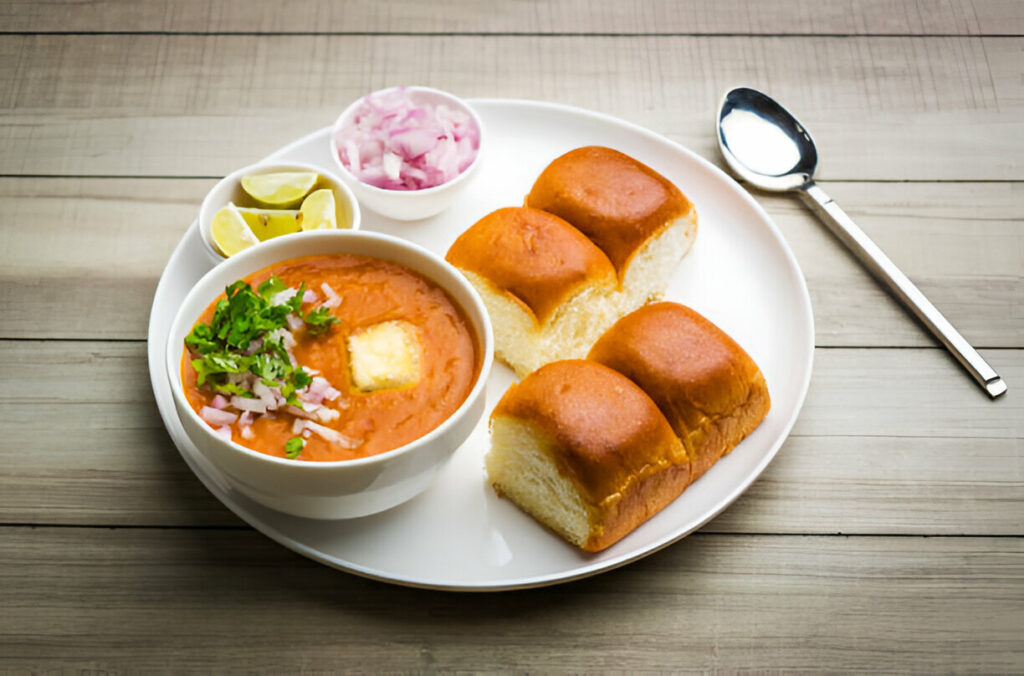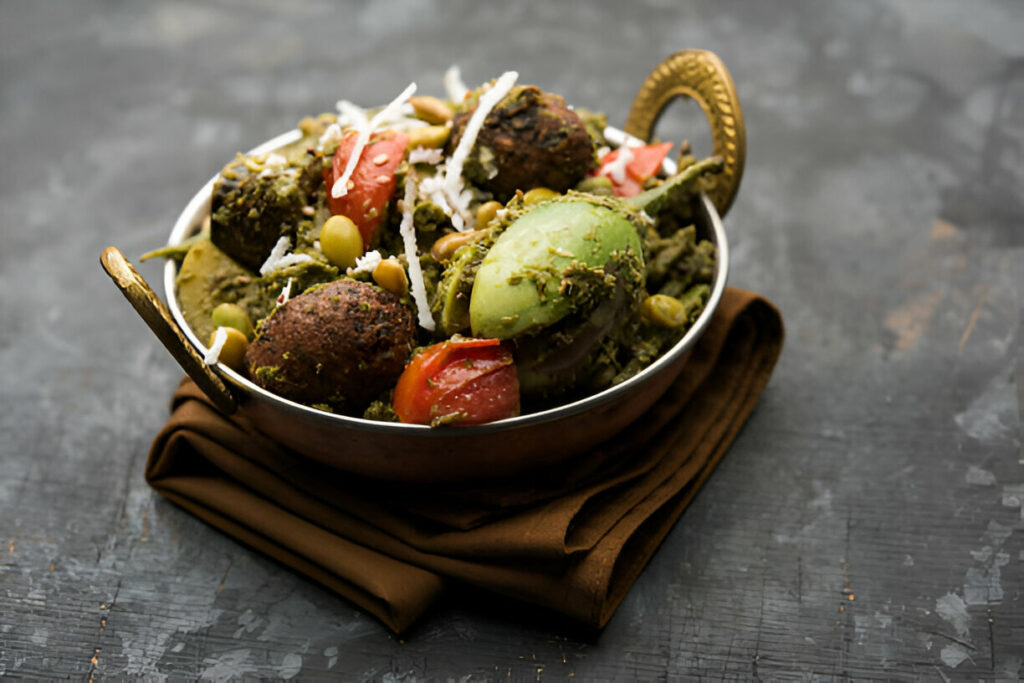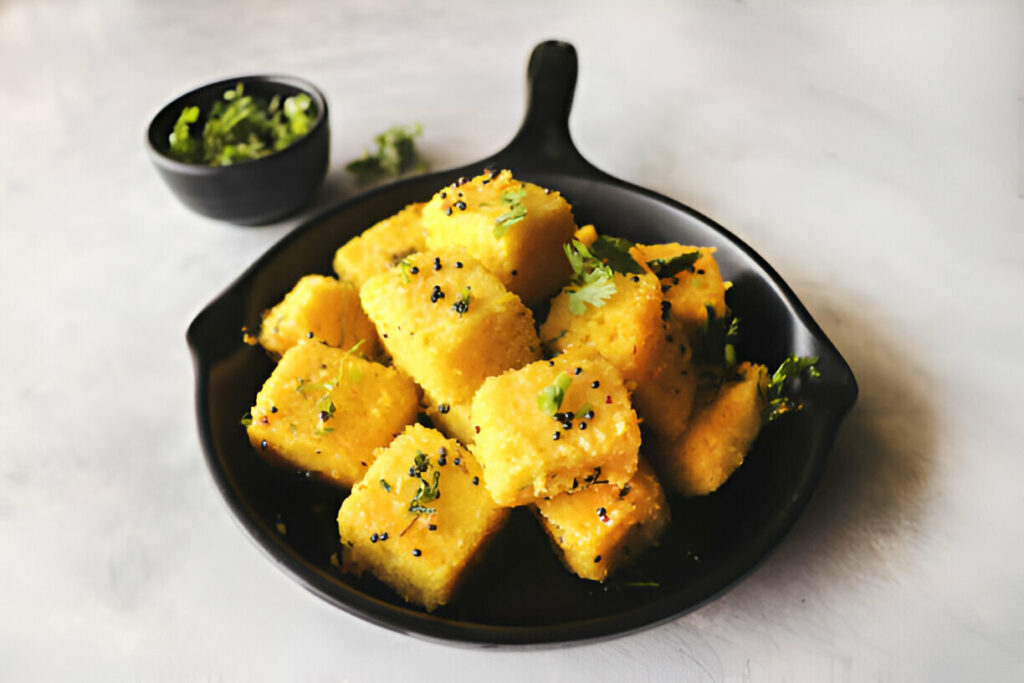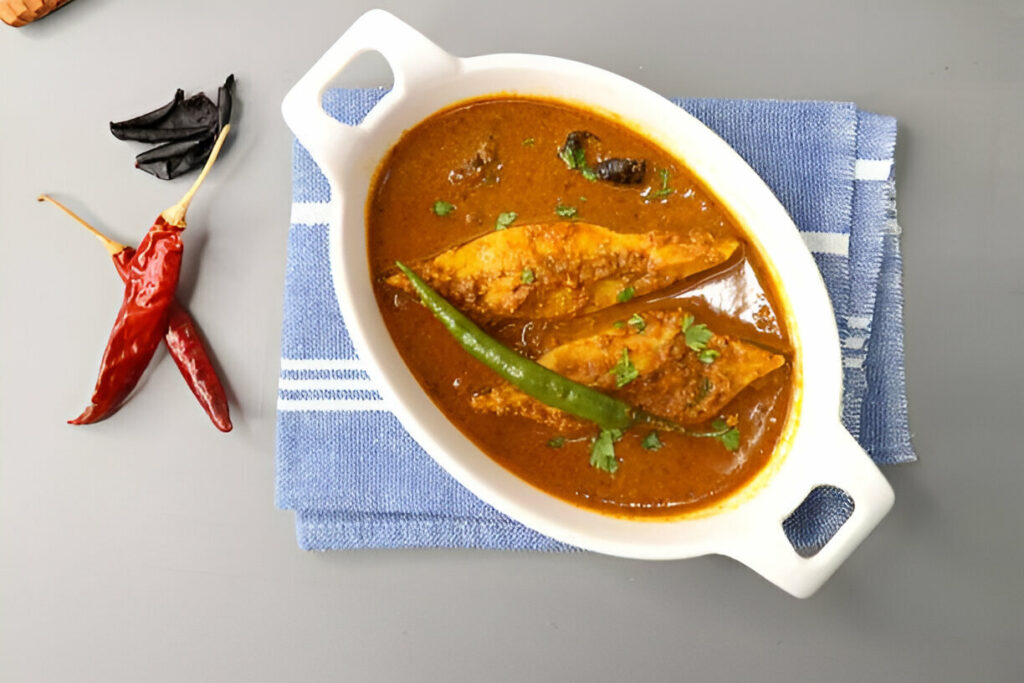West Indian
Indian Cuisines
Pav Bhaji
Pav Bhaji, Indian Street Food, Bharuch, Gujarat, India.
Undhiyu
Undhiyu is a Gujarati mixed vegetable dish, specialty of Surat, India. Served in a bowl with or without poori.
Dhokla
Indian chana Dal dhokla. Khaman dhokla is a famous dish of Gujarat. Made using rice, a healthy mix lentils and pulses, along with spices.
Goan Fish Curry
It typically features fresh fish cooked in a spicy and tangy coconut-based curry sauce.
Kohlapuri Chicken
Kolhapuri / Bombay chicken curry is a hot and spicy dish Mumbai, South India.

Pav Bhaji
Pav Bhaji is a popular Indian street food dish that originated in Mumbai, but is now enjoyed throughout India and beyond. It consists of a spicy vegetable mash (bhaji) typically made from potatoes, tomatoes, peas, bell peppers, and onions, cooked with a blend of spices such as cumin, coriander, turmeric, and chili powder. This mixture is served with buttered and toasted bread rolls (pav), which are often lightly toasted on a griddle with butter. The bhaji is usually cooked until the vegetables are tender and well blended, resulting in a flavorful and slightly spicy dish. It is often garnished with fresh coriander (cilantro), diced onions, a squeeze of lime or lemon juice, and a dollop of butter. Pav Bhaji is enjoyed as a hearty snack or a meal in itself, and it’s known for its rich taste and satisfying texture.
- Ingredients
- Method
Vegetables: Potatoes form the base, along with tomatoes, peas, bell peppers, and sometimes cauliflower or carrots.
Spices: Key spices include cumin seeds, coriander powder, turmeric, red chili powder, and garam masala.
Butter: Generous amounts are used for cooking and serving, adding richness to the dish.
Pav: Soft bread rolls, often buttered and lightly toasted.
Garnishes: Fresh coriander (cilantro), chopped onions, lemon or lime wedges.
- Cooking the Bhaji:
- Boil and mash the potatoes.
- Cook tomatoes, peas, bell peppers, and any other vegetables until soft.
- Add spices like cumin, coriander, turmeric, red chili powder, and garam masala.
- Mash everything together with a potato masher until the mixture is well combined and slightly chunky.
Tempering:
- Heat butter in a pan and add cumin seeds.
- Once they splutter, add chopped onions and sauté until golden brown.
- Add garlic paste and cook until fragrant.
- Mixing:
- Combine the mashed vegetables with the tempered onions and garlic.
- Add more butter as desired for richness and mix well.
- Adjust seasoning with salt and additional spices if needed.
Preparing the Pav:
- Slice the pav horizontally and lightly toast on a griddle with butter until golden brown and crisp on the outside.
Serving:
- Serve the hot bhaji with buttered pav.
- Garnish with chopped onions, fresh coriander, and a squeeze of lemon or lime juice.

Undhiyu
Undhiyo is a traditional Gujarati mixed vegetable dish that is typically made during the winter months when fresh green vegetables are abundant. It is a flavorful and aromatic dish made with a variety of vegetables such as green beans, peas, potatoes, eggplant, and sometimes plantain, along with fenugreek dumplings (muthiya) and spices. The vegetables are usually cooked together with a blend of spices like turmeric, coriander, cumin, and sometimes grated coconut. Undhiyo is often served with puris (deep-fried Indian bread) or roti. It’s known for its rich flavors and is popular not only in Gujarat but also among people who enjoy Gujarati cuisine worldwide.
- Ingredients
- Method
- Assorted winter vegetables (small eggplants, potatoes, sweet potatoes, purple yam, raw bananas, surati papdi beans, if available)
- Spices and masalas (green chili paste, ginger paste, garlic paste, turmeric powder, coriander-cumin powder, garam masala)
- Fresh grated coconut
- Fresh cilantro (coriander) leaves
- Sugar or jaggery (gur)
- Salt
- For tempering (tadka): mustard seeds, cumin seeds, asafoetida (hing), curry leaves
- Optional: cashew nuts or peanuts
- Puris (for serving)
- Prepare the Vegetables:
- Wash and prepare all the vegetables. Cut them into large chunks or keep them whole as per preference. If using surati papdi beans, remove the strings from both sides.
- Prepare the Masala Paste: In a bowl, mix together green chili paste, ginger paste, garlic paste, turmeric powder, coriander-cumin powder, garam masala, and a pinch of salt. Adjust spice levels according to taste.
Stuff the Vegetables (Optional):
- If desired, you can stuff some of the vegetables like small eggplants with the prepared masala paste. Make small incisions in the vegetables and fill them with the paste.
Cooking Undhiyu:
- Heat oil in a large, heavy-bottomed pot or a traditional clay pot (if available) over medium heat. Add mustard seeds and cumin seeds.
- Once the seeds splutter, add asafoetida (hing) and curry leaves. Sauté for a few seconds until fragrant.
- Add the stuffed or plain vegetables to the pot, along with any beans (like surati papdi) and raw bananas.
- Sprinkle a little salt over the vegetables. Add sugar or jaggery for a hint of sweetness.
- Mix gently to coat the vegetables with the tempering.
- Cover the pot and cook on low heat, stirring occasionally, for about 20-25 minutes or until the vegetables are tender.
Add Coconut and Coriander:
- Once the vegetables are almost cooked, add freshly grated coconut and chopped cilantro (coriander) leaves. Mix gently to combine.
Final Touch:
- Cook for another 5-10 minutes on low heat, allowing the flavors to blend well.
Serve:
- Serve hot undhiyu with puris or rotis. It pairs well with yogurt (dahi) and pickle (achar) on the side.

Dhokla
Dhokla is a savory steamed cake originating from the Indian state of Gujarat. It’s typically made from fermented batter derived from rice and split chickpeas (chana dal). Dhokla can be enjoyed as a breakfast dish, a snack, or even as part of a meal.It’s incredibly popular not just in Gujarat but all across India and even globally, thanks to its delicious taste and healthy steaming method.Dhokla is steamed, not fried, making it a healthier choice compared to many other snacks.It’s high in protein due to the gram flour (besan) and can be a good source of carbohydrates depending on the type of flour used.Dhokla is an integral part of Gujarati cuisine and is often served during festivals, celebrations, and special occasions.
- Ingredients
- Method
For the Dhokla Batter:
- 1 cup gram flour (besan)
- 1/4 cup fine semolina (sooji or rava)
- 1/2 cup plain yogurt (dahi), preferably sour
- 1/2 cup water (adjust as needed)
- 1 teaspoon ginger-green chili paste (or finely minced ginger and green chili)
- Salt, to taste
- 1 teaspoon sugar
- 1 tablespoon lemon juice
- 1 teaspoon fruit salt (eno or citric acid) or 1/2 teaspoon baking soda
For Tempering:
- 2 tablespoons oil
- 1 teaspoon mustard seeds
- 1 teaspoon cumin seeds
- 1-2 green chilies, slit
- 8-10 curry leaves
- A pinch of asafoetida (hing)
For Garnish:
- Fresh cilantro (coriander) leaves, chopped
- Fresh grated coconut (optional)
Prepare the Dhokla Batter:
- In a large mixing bowl, combine gram flour, fine semolina, yogurt, ginger-green chili paste, salt, sugar, and lemon juice.
- Gradually add water to make a smooth batter. The batter should be thick yet flowing consistency, similar to pancake batter.
- Set aside the batter to ferment for 4-5 hours or overnight in a warm place. The fermentation process helps in making the dhokla soft and fluffy.
Prepare the Steamer:
- Grease a dhokla plate or a shallow pan with oil.
Add Fruit Salt/Baking Soda:
- Just before steaming, add fruit salt (eno) or baking soda to the batter. Mix gently in one direction for about 1 minute until the batter becomes light and airy.
Steam the Dhokla:
- Pour the batter immediately into the greased plate. Tap the plate gently to spread the batter evenly.
- Place the plate in a steamer filled with enough water. Steam on medium heat for about 15-20 minutes or until a toothpick inserted into the dhokla comes out clean.
- Once steamed, remove the plate from the steamer and let it cool for a few minutes.
Prepare Tempering:
- Heat oil in a small pan. Add mustard seeds and cumin seeds. Allow them to crackle.
- Add slit green chilies, curry leaves, and a pinch of asafoetida (hing). Saute for a few seconds until fragrant.
- Pour this tempering evenly over the steamed dhokla.
Cut and Serve:
- Cut the dhokla into squares or diamond shapes.
- Garnish with chopped cilantro leaves and grated coconut (if using).

Goan Fish Curry
Goan fish curry is a flavorful and aromatic dish from the coastal region of Goa, India, known for its vibrant spices and rich coconut base. It is a delightful dish that showcases the bold flavors of Goa’s culinary heritage, combining spice, tanginess, and creaminess from coconut milk. It’s a must-try for seafood lovers and anyone who enjoys vibrant Indian cuisine!. You can customize the heat level by adjusting the amount of green chilies or using dried red chilies. Some variations also include adding tomatoes or kokum (a dried fruit used for sourness).Choose firm-fleshed fish that holds its shape well during cooking, such as kingfish or pomfret. However, you can use any white fish that is locally available and fresh.
- Ingredients
- Method
For the Curry Paste:
- 1 large onion, chopped
- 4-5 cloves garlic
- 1-inch piece of ginger, peeled
- 2-3 fresh green chilies (adjust to taste)
- 1 teaspoon turmeric powder
- 1 tablespoon coriander powder
- 1 teaspoon cumin powder
- 1/2 teaspoon black pepper
- 1/2 cup fresh grated coconut (or desiccated coconut soaked in warm water)
- 1 tablespoon tamarind paste (or lemon juice as a substitute)
- Salt, to taste
Other Ingredients:
- 500 grams fish (such as kingfish, pomfret, or any firm white fish), cut into pieces
- 1 cup coconut milk
- 1 tablespoon vegetable oil or coconut oil
- 1 teaspoon mustard seeds
- 6-8 curry leaves
- 1-2 dried red chilies (optional, for added heat)
- Fresh cilantro (coriander) leaves for garnish
Prepare the Curry Paste:
- In a blender or food processor, combine chopped onion, garlic cloves, ginger, green chilies, turmeric powder, coriander powder, cumin powder, black pepper, grated coconut, tamarind paste (or lemon juice), and salt.
- Blend until you get a smooth paste. You can add a little water if needed to facilitate blending.
Cooking the Curry:
- Heat oil in a large pan or pot over medium heat. Add mustard seeds and let them splutter.
- Add curry leaves and dried red chilies (if using), sauté for a few seconds until fragrant.
- Add the prepared curry paste to the pan. Cook the paste, stirring occasionally, for about 8-10 minutes until the raw smell diminishes and the paste thickens slightly.
Add Coconut Milk:
- Pour in the coconut milk and stir well to combine with the curry paste. Bring the mixture to a gentle simmer.
Add Fish:
- Carefully add the fish pieces to the simmering curry. Gently stir to coat the fish with the curry sauce.
- Cover the pan and let the fish cook in the curry for about 7-10 minutes or until the fish is cooked through and flakes easily with a fork.
Adjust Seasoning:
- Taste the curry and adjust salt and spice levels according to your preference. If you like it tangier, you can add a bit more tamarind paste or lemon juice.
Serve:
- Garnish the Goan fish curry with fresh cilantro (coriander) leaves.
- Serve hot with steamed rice or crusty bread to soak up the delicious sauce.

kohlapuri chicken
Kolhapuri Chicken is a spicy and flavorful dish from the Kolhapur region in Maharashtra, India. It is known for its rich red color and intense heat from a blend of aromatic spices. Kolhapuri Chicken is a delicious and aromatic dish that showcases the bold flavors of Kolhapur cuisine. It’s a wonderful choice for those who enjoy spicy Indian dishes with a rich and complex flavor profile. Kolhapuri Chicken can be stored in an airtight container in the refrigerator for up to 2-3 days. Like many Indian curries, it often tastes even better the next day as the flavors have more time to meld together. The amount of dried red chilies can be adjusted according to your heat preference. Kolhapuri cuisine is known for its spiciness, so it’s traditionally quite hot.
- Ingredients
- Method
For Marination:
- 500 grams chicken, cut into pieces
- 1 tablespoon yogurt (curd)
- 1 teaspoon turmeric powder
- Salt, to taste
For Kolhapuri Masala Paste:
- 1 large onion, roughly chopped
- 4-5 cloves garlic
- 1-inch piece of ginger, peeled
- 5-6 dried red chilies (adjust according to heat preference)
- 1 tablespoon coriander seeds
- 1 teaspoon cumin seeds
- 1 teaspoon black peppercorns
- 4-5 cloves
- 4-5 green cardamom pods
- 1-inch cinnamon stick
- 1/2 teaspoon fenugreek seeds
- 1/2 cup grated coconut (fresh or desiccated)
- 1 tablespoon poppy seeds (khus khus), optional
- 1 tablespoon sesame seeds, optional
- Water, as needed
Other Ingredients:
- 2 tablespoons vegetable oil
- 1 bay leaf
- 1 teaspoon mustard seeds
- 1 teaspoon cumin seeds
- 2-3 dried red chilies
- A few curry leaves
- 2 large tomatoes, finely chopped
- Salt, to taste
- Fresh cilantro (coriander) leaves for garnish
Marinate the Chicken:
- In a bowl, combine chicken pieces with yogurt, turmeric powder, and salt. Mix well to coat the chicken evenly. Set aside for at least 30 minutes.
Prepare Kolhapuri Masala Paste:
- Dry roast coriander seeds, cumin seeds, black peppercorns, cloves, green cardamom pods, cinnamon stick, and fenugreek seeds in a pan until fragrant. Be careful not to burn them.
- In the same pan, dry roast dried red chilies until they are slightly darkened and aromatic.
- In a blender or food processor, combine roasted spices with onion, garlic, ginger, grated coconut, poppy seeds (if using), and sesame seeds (if using). Add a little water and blend into a smooth paste. Set aside.
Cooking Kolhapuri Chicken:
- Heat oil in a large pan or kadhai over medium heat. Add bay leaf, mustard seeds, and cumin seeds. Let them crackle.
- Add dried red chilies and curry leaves. Sauté for a few seconds until fragrant.
- Add the chopped tomatoes and cook until they turn soft and the oil starts to separate from the masala.
- Add the prepared Kolhapuri masala paste to the pan. Cook the masala paste, stirring continuously, for about 10-12 minutes until the raw smell diminishes and the masala thickens.
Add Marinated Chicken:
- Add the marinated chicken pieces to the masala paste. Mix well to coat the chicken pieces with the masala.
- Adjust salt according to taste. Cover the pan and cook the chicken on medium-low heat for about 15-20 minutes, stirring occasionally, until the chicken is tender and cooked through.
Finish and Serve:
- Once the chicken is cooked, garnish with fresh cilantro (coriander) leaves.
- Serve Kolhapuri Chicken hot with steamed rice or roti (Indian flatbread).
